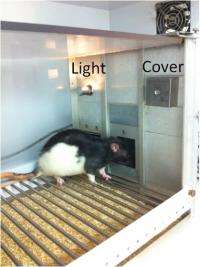What do animals 'know'? More than you may think

(PhysOrg.com) -- Rats use their knowledge to make decisions when faced with ambiguous situations, UCLA psychologists report.
"Rats often make judgments and behave as if they're rational creatures," said UCLA associate professor of psychology Aaron Blaisdell, a member of UCLA's Brain Research Institute and senior author of a new study published in the December issue of the journal Psychonomic Bulletin and Review.
"To make a decision in the face of uncertainty, rats call on prior history and reasoning," Blaisdell said. "They apply what they know to a situation where they are uncertain. The rats are not necessarily thinking like little humans, but they have learned through experience. A lot of animal behavior seems to be rational. Their behavior follows logical inferences."
Blaisdell, an expert in animal cognition (he avoids the phrase "animal intelligence"), and Cynthia Fast, the study's lead author and a UCLA graduate student in psychology, report on a series of experiments in which 74 female rats were rewarded with a sugar solution — which rats like about as much as teenagers like soda, Blaisdell said — for pressing a lever under certain conditions but not under others, which they learned to differentiate.
The rats, none of which were harmed, first learned to expect the sugar reward if they pressed a lever when they saw one of two lights illuminated in their enclosure but not when they saw both lights on. After learning this pattern in 90 days, the rats were shown only one illuminated light while the other light was covered. In this case, the rats searched less for the sugar solution, as if both lights were on. This indicated, Blaisdell said, that the rats imagined the other light to be on, even though they could not see it.
"Their behavior is consistent with their having an image of the light being on," Blaisdell said. "When we didn't cover the light, they knew what decision to make. They have the ability to hold an image of something that is not there and make a decision based on that."
"Their prior learning influenced how they perceived this ambiguity," Fast said. "The rats responded less in this condition than they would if there was just a single light but more than they would if both lights were on. It would be like your driving on your commute and approaching an intersection where you know there is a traffic light but you can't see it because a tree branch or a bus in front of you is blocking your view. You approach slowly until you're able to see if the light is red or green. The rats seem to be doing the same thing. It's as if they reason, 'Hmm, I can't see the light on the right; maybe it's on,' and they press the lever less than they would if there were just a single light on."
In another experiment, rats were given the reward only if they pressed a lever when both lights were on, but not when either light was on alone — a pattern they learned much more quickly (in only 30 days). Then the psychologists covered one of the lights to study how the rats would respond.
What was surprising, they said, was that covering the light in this case did not seem to have any impact on the rats' decision to respond. They continued to behave as if they were certain that the covered light was not on.
To find out why, the researchers conducted a follow-up experiment in which the rats were again given the reward for pressing the lever when both lights were on (but not when only one was on), and they were also given the reward if they pressed the lever when they heard a tone or a clicking sound — but not the tone and clicking sound simultaneously. Other rats were given the reward only if the tone and clicking sound occurred together, not separately.
"The rats are capable of learning that too," Fast said. "They learn to differentiate among these different lights and different auditory cues and can tell them all apart."
"It takes them a long time," Blaisdell said.
The rats were more sensitive to ambiguity when the uncertainty followed the more challenging training involving both the lights and the auditory cues, even in the condition that failed to make a difference previously, Fast and Blaisdell report.
"The difficulty of the task the rats are engaged in affects how they deal with uncertainty," Blaisdell said. "When the task is more difficult, they address it in a more sophisticated fashion. As far as I know, that has not been shown with any animal before."
Little is known about how human imagination works, but an understanding of how widespread imagination is across the animal kingdom can shed light on the origins of imagination,
Blaisdell said.
The aging brain
The ability to make decisions in ambiguous situations declines with age, Blaisdell and Fast noted.
"With aging, decision-making becomes more fragile, especially in the face of lack of information," Blaisdell said.
Blaisdell is interested in learning the brain mechanisms involved in decision-making and perhaps applying this research to human cognition and neural changes that occur with aging or with degenerative diseases. He also hopes to gain new insights into how we learn.
"There is still so much we don't know about learning," he said. "The more we can understand about how the brain supports cognition, the more we will be able to look for where cognition is going wrong when the brain malfunctions."
Provided by University of California Los Angeles













